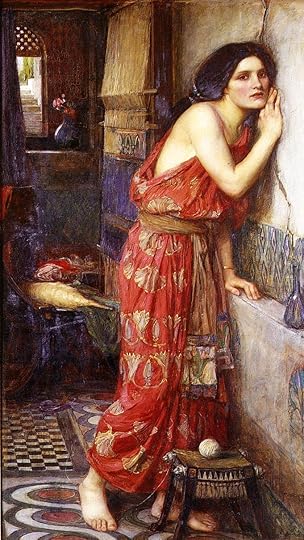 Kalliope’s
Comments
(group member since Aug 28, 2018)
Kalliope’s
Comments
(group member since Aug 28, 2018)
Kalliope’s
comments
from the Ovid's Metamorphoses and Further Metamorphoses group.
Showing 341-360 of 610
 Fionnuala wrote: "
Fionnuala wrote: "I wish I could remember the connection..."
I don't remember this at all...!!!!
I will have to hire your brains for a little while, Fionnuala.
Since I am planning to restart Proust now I have one more thing to look for...
 With Chapter IV, and reading this Thread late, I feel as if I had fallen into Hades and had joined Sisyphus and the like embarking also on an endless task,
With Chapter IV, and reading this Thread late, I feel as if I had fallen into Hades and had joined Sisyphus and the like embarking also on an endless task, I just hope I don't meet Juno. But if I do, I shall laugh at her - she is always ridiculous.
:)
 Fionnuala wrote: "I've moved on to the section on Juno visiting the underworld, and I've come across the reference to Tantalus which reminded me of Proust. I'm certain he referred to Tantalus in his 'Recherche du Te..."
Fionnuala wrote: "I've moved on to the section on Juno visiting the underworld, and I've come across the reference to Tantalus which reminded me of Proust. I'm certain he referred to Tantalus in his 'Recherche du Te..."Fionnuala, I have searched 'Tantale' in my Kindle edition of the entire Proust, but could not find anything.
 Roman Clodia wrote: "Oh, and I noticed, too, that when Salmacis had H in her clutches and there's that simile of an eagle (c.360), she's also likened to 'the ivy which weaves its way around the length of a tree-trunk' - ivy is associated with Bacchus and we see later how it springs out of the looms of the Minyeides as they're turned into bats. .."
Roman Clodia wrote: "Oh, and I noticed, too, that when Salmacis had H in her clutches and there's that simile of an eagle (c.360), she's also likened to 'the ivy which weaves its way around the length of a tree-trunk' - ivy is associated with Bacchus and we see later how it springs out of the looms of the Minyeides as they're turned into bats. .."Thank you for this post, RC.
I also noticed the imagery Ovid uses for when Salmacis has H in her clutches... it made me smile... the vine... and then the Octopus... Humour intended here as well?
 The passage describing the pleasure Salmacis is enjoying when she is bathing, before she spots Hermaphroditus, struck me as a perfect theme for paintings - another excuse for pure voyerism and the display of the female figure. So I have searched for depictions of herself alone, with not much success.
The passage describing the pleasure Salmacis is enjoying when she is bathing, before she spots Hermaphroditus, struck me as a perfect theme for paintings - another excuse for pure voyerism and the display of the female figure. So I have searched for depictions of herself alone, with not much success. There is this piece of sculpture in which the attention she is paying to her toes is striking and evokes the whole passage.
François-Joseph Bosio. 1826. Louvre.
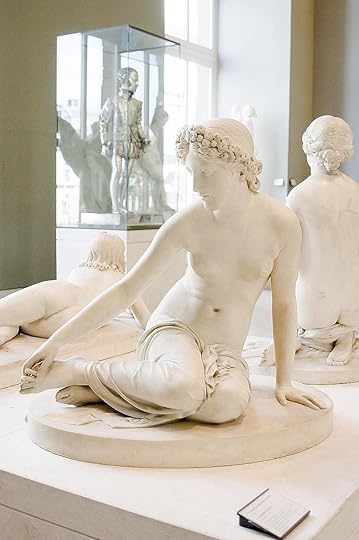
I also found this one of both of them, or rather of Hermaphroditus (already looking somewhat soft) and being spied on by Salmacis. From the Dutch school.
Samuel van Hoogstrtten. 1671-76. The Leiden Collection.
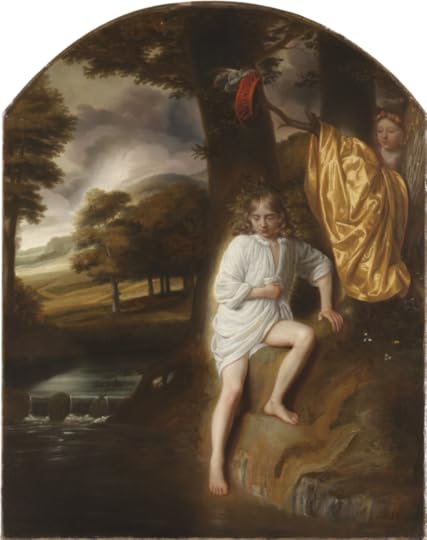
(I believe it has not been noted so far that his name is the conflation of the names of his parents - in Greek - Hermes [Mercury] and Venus [Aphrodita],
 Dear all,
Dear all,I am trying to catch up posting comments on issues already commented or replying to previous comments.
The discussion is so rich that I may have missed someone's post/comment and I may be writing/saying something that has already been posted.
My most sincere apologies.
 Nora wrote: "#13 the third rejected story
Nora wrote: "#13 the third rejected storyIt is generally assumed that this bewitching sea nymph and her fish victims also belong to the Near East tradition as previous two. Parallel with Circe could be found ..."
Thank you, Nora for this post. I particularly enjoyed the notes you make on the untold stories...
 Roger wrote: "What, if anything, fo you think, is the relationship between the Velázquez and the subject of Mars in the Forge of Vulcan that I posted at 4/104?
Roger wrote: "What, if anything, fo you think, is the relationship between the Velázquez and the subject of Mars in the Forge of Vulcan that I posted at 4/104? Nice to have your pictures again! R."
I don't understand your question, Roger. There is no Mars in the Velázquez. It is the scene when Apollo goes to Vulcan to tell him about his wife (and Mars).
Velázquez painted a Mars on his own, again, a rather peculiar one, but there is no direct relationship with Ovid.
 Sorry, but I will be going back in themes..
Sorry, but I will be going back in themes..On Apollo and Vulcan - there is this painting by Velazquez which will not show up easily in a Google search.
Velázquez. Apollo in the Forge of Vulcan. 1630. Prado.
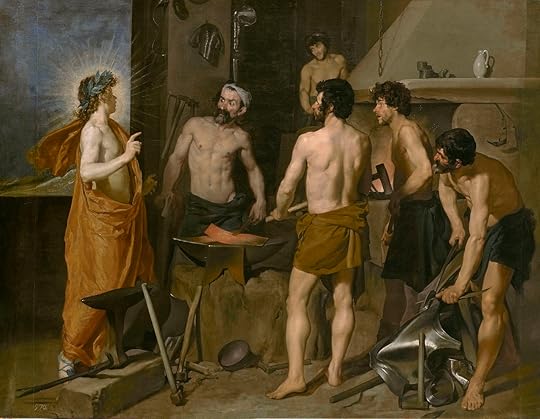
Which he apparently based it on a print by Antonio Tempesta.
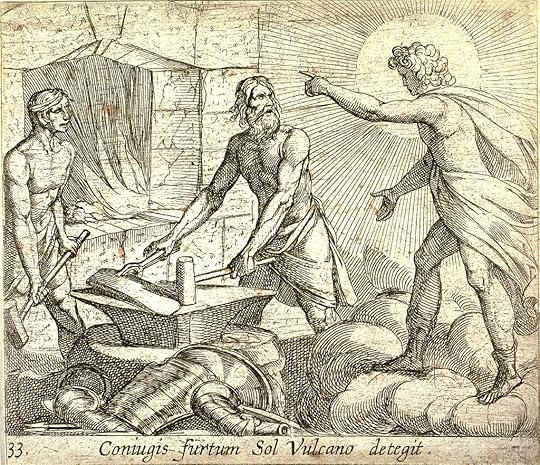
Velázquez has emphasised the difference between the Apollo and Vulcan - both are gods but only the former one seems so. Vulcan and his coworkers, who incidentally, and ironically, are forging armament.
As with the other mythological painting by Velázquez, his treatment of the theme seems ambiguous and points to a further theme associated with the story. One of the suggested ones is the contrast between the Major and Minor arts.
 Hello everyone. I am back.
Hello everyone. I am back. After two weeks away and finding other stuff piling up for me back home, I am now rereading the whole thread for this chapter, rereading the chapter itself and writing my own Plan.
I have just a few things to comment already, but I have to read first the whole thread.
 Nora, my edition cites the following sources for the various names.
Nora, my edition cites the following sources for the various names.Bromius - alluding to the noisy celebrations of Bacchic rites.
Lyaeus - referring to the relaxing effect of wine.
Nyseus - a reference to Mount Nysa, where the god was born or reared.
Thyoneus - a reference to his mother under the name Throne or to his nurse.
Lenaeus - referring to the wine press and a yearly Attic dramatic festival.
Nyctelius - supposedly a compound of two Greek words that refer to the nocturnal rites of god.
Eleleus - denotes the wild cry with which worshippers called on deity.
Iacchus - name associated with Dionisus at Eleusis.
Euhan - derives from one of the standard outcries at the rites.
Liber - referring to an old Italian agricultural deity, as well as to 'libare' - to pour. Additionally it also offers the pun with the word 'liber' meaning to free.
 Nora wrote: "#13 the third rejected story
Nora wrote: "#13 the third rejected storyIt is generally assumed that this bewitching sea nymph and her fish victims also belong to the Near East tradition as previous two. Parallel with Circe could be found ..."
Nora, I love your posts... So much to think about... I will come back to the structure as I feel more comfortable with the chapter, but your comments are certainly very helpful in following Ovid's intricate paths.
 Roger wrote: "The Rubens sketch IS the Arachne story, isn't it? One of the designs for the Torre de la Parada. Pallas is falling on Arachne and attacking her with a shuttle. Not in this Book, so I haven't come t..."
Roger wrote: "The Rubens sketch IS the Arachne story, isn't it? One of the designs for the Torre de la Parada. Pallas is falling on Arachne and attacking her with a shuttle. Not in this Book, so I haven't come t..."Yes, of course it is the Arachne story, and so is the Velázquez. What I want to explore is the possible conflation of the two iconographies - and then the Dolce edition of the Ovid is probably key. I wish I could get hold of a copy.
If the date for the Rubens sketch is 1626, as the Virginia museum thinks, then it would not have been for the Torre de la Parada. Had it been for the Torre then Velázquez would have known it.
I have Alpers's PhD thesis on the Torre but it is in the attic - a thick book. We had an exhibition on Rubens's oil sketches this year in the Prado. It was fabulous. But this one was not there.
My understanding is that the Milnyas daughters are presented at the very beginning of the chapter - even if their punishment comes after they have told their stories. Some images give their full story, some only show them weaving, as we first meet them.
 We have jumped over Minyas daughters in the visual arts.
We have jumped over Minyas daughters in the visual arts.From a medieval manuscript.
Ms 742f. 1385. Lyon Municipal Library.
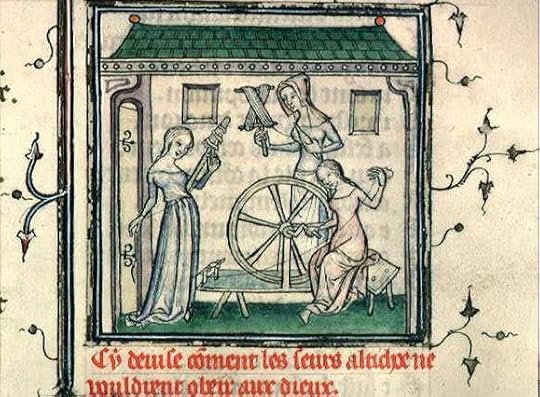
Picasso's version is very beautiful. I have always liked his etchings and drawings of classical themes.
Pablo Picasso. 1930-31. Metropolitan.
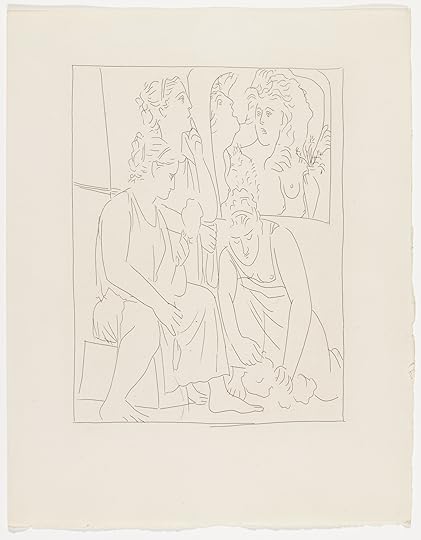
Cerammic plate. Possibly Urbino. Before 1544. British Museum.
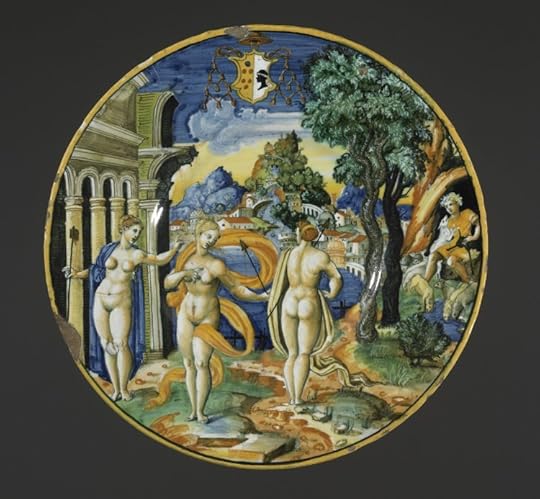
At first I thought the three women could represent the three graces, but Bacchus in the cave on the right shift the identification to the Minyas women.
The BM thinks it could come from Urbino, but I recognise the coat of arms from a painting by Botticelli in the Prado to correspond to the Medici and Pucci families - the Puccis were also based in Florence.
The print below that shows two scenes - with the Bacchantes and the Daughters with a few bats flying over them - is unidentified in the blog where I found it.
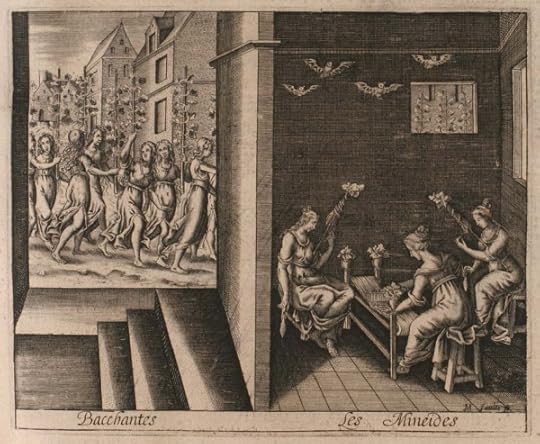
This one I find quite daunting.
Jean Lepautre. Etching. 1676. Washington Gallery of Art.
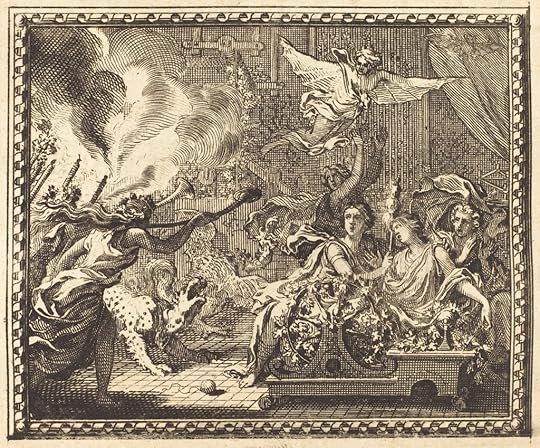
Antonio Fantucci. After Francesco Primaticcio. 1545. Metropolitan.

And most interesting for me, this sketch by Rubens, since it also shows women weaving AND a tapestry with the Europa myth.....
Rubens. 1626. Virginia Museum of Fine Arts.
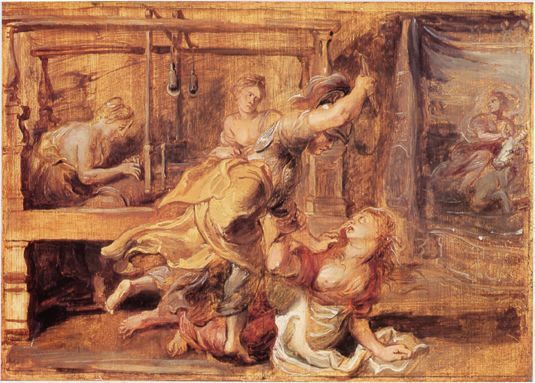
Going back to the Velázquez painting, I read somewhere (again, I have to trace back the source - but I already found the one that argues that the strange looking artefact is not a musical instrument) is that Velázquez had an edition of the Ovid, translated by Dolce, which had, mistakenly, an illustration of Minyas daughters at the head of Chapter VI (that, as we will see, deals with the Arachne and Minerva myth).
This last thread (!!) I will want to pursue...
 Nora wrote: " Repeating of 2nd person pronoun "tu" (7 times!) and listing of many names in particular metrical places, very clever chosen, really sounds as a hymn, or, even more - Ovid personal prayer to his favorite deity..."
Nora wrote: " Repeating of 2nd person pronoun "tu" (7 times!) and listing of many names in particular metrical places, very clever chosen, really sounds as a hymn, or, even more - Ovid personal prayer to his favorite deity..."Nora, it really struck me how he switched so abruptly from the 3rd Person to this direct speech... and I found it amusing that Ovid seems to want to put himself on the 'safe side' with this unpredictable god.
 Nora wrote: "Dionysus, Ovid's favorite god, will play main role again. I have impression that this Book is something like "defense" of Dionysus (I call it "apologia Dionyisana"), where he is explaining what that new deity means (to him)..."
Nora wrote: "Dionysus, Ovid's favorite god, will play main role again. I have impression that this Book is something like "defense" of Dionysus (I call it "apologia Dionyisana"), where he is explaining what that new deity means (to him)..."Simpson in his notes draws attention to the fact that the Narrator, at the beginning of Bk IV picks up with his own voice the hymn that the Theban women are singing in honor of Bacchus..
.. since he knows the outcome of the Minyades's blasphemy, which takes the form of working and telling stories, Ovid, also a storyteller, dissociates himself from it by, as it were, singing the god's hymn, directly quoting the last four words of the women singing the hymn in the last line.
 Peter wrote: "
Peter wrote: "Returning Bacchantes by Lovis Corinth, oil on canvas, Von der Heydt-Museum, Wuppertal"
Wonderful Peter.. Good to have someone else posting images, apart from Roger and I.
I did not know this Corinth.
 Roger wrote: "Do report back if you find that reference. ..."
Roger wrote: "Do report back if you find that reference. ..."Svetlana Alpers in her The Vexations of Art: Velázquez and Others. Chapter 6 -footnote refers to a study by Maria Luis Caturla.
But I think I have seen it elsewhere as well.
That curve is just too exaggerated.
 I am off tomorrow for two weeks. I will continue to read Ovid and will also try to follow the discussion here but I many not be able to comment much.
I am off tomorrow for two weeks. I will continue to read Ovid and will also try to follow the discussion here but I many not be able to comment much.I am already looking forward to coming back to this discussion/read more actively.
 I like this painting of Thisbe listening through the crack on the wall.
I like this painting of Thisbe listening through the crack on the wall.John William Waterhouse. Thisbe. 1909. Private collection.
